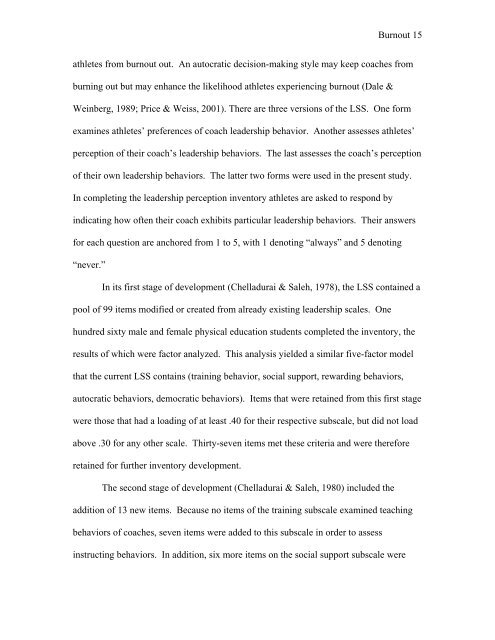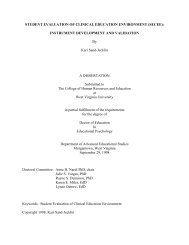Coach and Athlete Burnout - West Virginia University
Coach and Athlete Burnout - West Virginia University
Coach and Athlete Burnout - West Virginia University
Create successful ePaper yourself
Turn your PDF publications into a flip-book with our unique Google optimized e-Paper software.
<strong>Burnout</strong> 15<br />
athletes from burnout out. An autocratic decision-making style may keep coaches from<br />
burning out but may enhance the likelihood athletes experiencing burnout (Dale &<br />
Weinberg, 1989; Price & Weiss, 2001). There are three versions of the LSS. One form<br />
examines athletes’ preferences of coach leadership behavior. Another assesses athletes’<br />
perception of their coach’s leadership behaviors. The last assesses the coach’s perception<br />
of their own leadership behaviors. The latter two forms were used in the present study.<br />
In completing the leadership perception inventory athletes are asked to respond by<br />
indicating how often their coach exhibits particular leadership behaviors. Their answers<br />
for each question are anchored from 1 to 5, with 1 denoting “always” <strong>and</strong> 5 denoting<br />
“never.”<br />
In its first stage of development (Chelladurai & Saleh, 1978), the LSS contained a<br />
pool of 99 items modified or created from already existing leadership scales. One<br />
hundred sixty male <strong>and</strong> female physical education students completed the inventory, the<br />
results of which were factor analyzed. This analysis yielded a similar five-factor model<br />
that the current LSS contains (training behavior, social support, rewarding behaviors,<br />
autocratic behaviors, democratic behaviors). Items that were retained from this first stage<br />
were those that had a loading of at least .40 for their respective subscale, but did not load<br />
above .30 for any other scale. Thirty-seven items met these criteria <strong>and</strong> were therefore<br />
retained for further inventory development.<br />
The second stage of development (Chelladurai & Saleh, 1980) included the<br />
addition of 13 new items. Because no items of the training subscale examined teaching<br />
behaviors of coaches, seven items were added to this subscale in order to assess<br />
instructing behaviors. In addition, six more items on the social support subscale were












